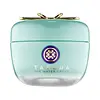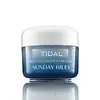What's inside
What's inside
 Key Ingredients
Key Ingredients

 Benefits
Benefits

 Concerns
Concerns

 Ingredients Side-by-side
Ingredients Side-by-side

Water
Skin ConditioningSaccharomyces/Rice Ferment Filtrate
Skin ConditioningDimethicone
EmollientPropanediol
SolventGlycerin
HumectantDiglycerin
HumectantDiphenylsiloxy Phenyl Trimethicone
Skin ConditioningCamellia Sinensis Leaf Extract
AntimicrobialCladosiphon Okamuranus Extract
Skin ConditioningPEG-9 Polydimethylsiloxyethyl Dimethicone
EmulsifyingGold
Cosmetic ColorantBelamcanda Chinensis Root Extract
Skin ConditioningRosa Multiflora Fruit Extract
MaskingHouttuynia Cordata Extract
Skin ConditioningSophora Angustifolia Root Extract
Skin ConditioningSodium Hyaluronate
HumectantLecithin
EmollientPistacia Lentiscus Gum
MaskingSodium Chloride
MaskingSodium Citrate
BufferingMica
Cosmetic ColorantTin Oxide
AbrasiveDimethicone/PEG-10/15 Crosspolymer
Dimethicone/Phenyl Vinyl Dimethicone Crosspolymer
Tocopherol
AntioxidantButylene Glycol
HumectantEthylhexylglycerin
Skin ConditioningDipropylene Glycol
HumectantParfum
MaskingAlcohol
AntimicrobialPhenoxyethanol
PreservativeLimonene
PerfumingLinalool
PerfumingCitral
PerfumingCI 77891
Cosmetic ColorantWater, Saccharomyces/Rice Ferment Filtrate, Dimethicone, Propanediol, Glycerin, Diglycerin, Diphenylsiloxy Phenyl Trimethicone, Camellia Sinensis Leaf Extract, Cladosiphon Okamuranus Extract, PEG-9 Polydimethylsiloxyethyl Dimethicone, Gold, Belamcanda Chinensis Root Extract, Rosa Multiflora Fruit Extract, Houttuynia Cordata Extract, Sophora Angustifolia Root Extract, Sodium Hyaluronate, Lecithin, Pistacia Lentiscus Gum, Sodium Chloride, Sodium Citrate, Mica, Tin Oxide, Dimethicone/PEG-10/15 Crosspolymer, Dimethicone/Phenyl Vinyl Dimethicone Crosspolymer, Tocopherol, Butylene Glycol, Ethylhexylglycerin, Dipropylene Glycol, Parfum, Alcohol, Phenoxyethanol, Limonene, Linalool, Citral, CI 77891
Water
Skin ConditioningPropanediol
SolventGlycerin
HumectantCaprylic/Capric Triglyceride
MaskingEthyl Macadamiate
Skin ConditioningHydrolyzed Jojoba Esters
Skin ConditioningDicaprylyl Carbonate
EmollientIsododecane
EmollientSodium Acrylates Copolymer
Alpha-Arbutin
AntioxidantPhenoxyethanol
PreservativeCucumis Sativus Extract
Skin ConditioningPentylene Glycol
Skin ConditioningAdipic Acid/Neopentyl Glycol Crosspolymer
Lauryl Dimethicone
Skin ConditioningHydrogenated Polyisobutene
EmollientAllantoin
Skin ConditioningTetrasodium EDTA
Strelitzia Nicolai Seed Aril Extract
Skin ConditioningTamarindus Indica Seed Gum
Emulsion StabilisingAesculus Hippocastanum Seed Extract
Skin ConditioningSodium Hyaluronate Crosspolymer
HumectantSodium Hyaluronate
HumectantPapain
Skin ConditioningCarbomer
Emulsion Stabilising1,2-Hexanediol
Skin ConditioningAlgin
MaskingCaprylyl Glycol
EmollientLecithin
EmollientMelia Azadirachta Leaf Extract
Skin ConditioningMelia Azadirachta Flower Extract
Skin ConditioningCoccinia Indica Fruit Extract
Skin ConditioningSolanum Melongena Fruit Extract
Skin ConditioningAloe Barbadensis Flower Extract
EmollientOcimum Sanctum Leaf Extract
Skin ConditioningOcimum Basilicum Flower/Leaf Extract
TonicCurcuma Longa Root Extract
MaskingCorallina Officinalis Extract
Skin ConditioningEthylhexylglycerin
Skin ConditioningSodium Benzoate
MaskingPotassium Benzoate
PreservativeChlorphenesin
AntimicrobialTocopherol
AntioxidantMalic Acid
BufferingSynthetic Fluorphlogopite
Titanium Dioxide
Cosmetic ColorantTin Oxide
AbrasiveWater, Propanediol, Glycerin, Caprylic/Capric Triglyceride, Ethyl Macadamiate, Hydrolyzed Jojoba Esters, Dicaprylyl Carbonate, Isododecane, Sodium Acrylates Copolymer, Alpha-Arbutin, Phenoxyethanol, Cucumis Sativus Extract, Pentylene Glycol, Adipic Acid/Neopentyl Glycol Crosspolymer, Lauryl Dimethicone, Hydrogenated Polyisobutene, Allantoin, Tetrasodium EDTA, Strelitzia Nicolai Seed Aril Extract, Tamarindus Indica Seed Gum, Aesculus Hippocastanum Seed Extract, Sodium Hyaluronate Crosspolymer, Sodium Hyaluronate, Papain, Carbomer, 1,2-Hexanediol, Algin, Caprylyl Glycol, Lecithin, Melia Azadirachta Leaf Extract, Melia Azadirachta Flower Extract, Coccinia Indica Fruit Extract, Solanum Melongena Fruit Extract, Aloe Barbadensis Flower Extract, Ocimum Sanctum Leaf Extract, Ocimum Basilicum Flower/Leaf Extract, Curcuma Longa Root Extract, Corallina Officinalis Extract, Ethylhexylglycerin, Sodium Benzoate, Potassium Benzoate, Chlorphenesin, Tocopherol, Malic Acid, Synthetic Fluorphlogopite, Titanium Dioxide, Tin Oxide
 Reviews
Reviews

Ingredients Explained
These ingredients are found in both products.
Ingredients higher up in an ingredient list are typically present in a larger amount.
Ethylhexylglycerin (we can't pronounce this either) is commonly used as a preservative and skin softener. It is derived from glyceryl.
You might see Ethylhexylglycerin often paired with other preservatives such as phenoxyethanol. Ethylhexylglycerin has been found to increase the effectiveness of these other preservatives.
Glycerin is already naturally found in your skin. It helps moisturize and protect your skin.
A study from 2016 found glycerin to be more effective as a humectant than AHAs and hyaluronic acid.
As a humectant, it helps the skin stay hydrated by pulling moisture to your skin. The low molecular weight of glycerin allows it to pull moisture into the deeper layers of your skin.
Hydrated skin improves your skin barrier; Your skin barrier helps protect against irritants and bacteria.
Glycerin has also been found to have antimicrobial and antiviral properties. Due to these properties, glycerin is often used in wound and burn treatments.
In cosmetics, glycerin is usually derived from plants such as soybean or palm. However, it can also be sourced from animals, such as tallow or animal fat.
This ingredient is organic, colorless, odorless, and non-toxic.
Glycerin is the name for this ingredient in American English. British English uses Glycerol/Glycerine.
Learn more about GlycerinLecithin is a term for a group of substances found in the cell membranes of plants, animals, and humans. They are made up of mixture of phospholipids.
This ingredient has emollient and emulsifying properties.
As an emollient, lecithen helps soften the skin and creates a barrier to keep moisture in.
As an emulsifier, it also helps prevent water and oil ingredients from separating. Lecithin can also help ingredients be better absorbed by the skin.
This is because the phospholipids in lecithin produce liposomes. Liposomes help other ingredients get through the skin barrier.
Depending on the source of this ingredient, lecithin may not be fungal acne safe. This is because some sources of lecithin come from soybean oil, which may feed the malassezia yeast that feeds fungal acne.
We recommend reaching out to the brand you are purchasing from to inquire about the source of their lecithin.
Some other names for this ingredient include soy lecithin and deoiled soy lecithin.
Learn more about LecithinPhenoxyethanol is a preservative that has germicide, antimicrobial, and aromatic properties. Studies show that phenoxyethanol can prevent microbial growth. By itself, it has a scent that is similar to that of a rose.
It's often used in formulations along with Caprylyl Glycol to preserve the shelf life of products.
Propanediol is an all-star ingredient. It softens, hydrates, and smooths the skin.
It’s often used to:
Propanediol is not likely to cause sensitivity and considered safe to use. It is derived from corn or petroleum with a clear color and no scent.
Learn more about PropanediolSodium Hyaluronate is hyaluronic acid's salt form. It is commonly derived from the sodium salt of hyaluronic acid.
Like hyaluronic acid, it is great at holding water and acts as a humectant. This makes it a great skin hydrating ingredient.
Sodium Hyaluronate is naturally occurring in our bodies and is mostly found in eye fluid and joints.
These are some other common types of Hyaluronic Acid:
Learn more about Sodium HyaluronateTin Oxide is an inorganic oxide used to add opacity and volume to a product. In nature, it is already found in mineral form. The main ore of tin is an opaque and shiny mineral called casseterite.
Tin Oxide helps remove translucency in a product, or make it more opaque. Besides adding opacity, tin oxide is used for bulking to add volume.
Tocopherol (also known as Vitamin E) is a common antioxidant used to help protect the skin from free-radicals and strengthen the skin barrier. It's also fat soluble - this means our skin is great at absorbing it.
Vitamin E also helps keep your natural skin lipids healthy. Your lipid skin barrier naturally consists of lipids, ceramides, and fatty acids. Vitamin E offers extra protection for your skin’s lipid barrier, keeping your skin healthy and nourished.
Another benefit is a bit of UV protection. Vitamin E helps reduce the damage caused by UVB rays. (It should not replace your sunscreen). Combining it with Vitamin C can decrease sunburned cells and hyperpigmentation after UV exposure.
You might have noticed Vitamin E + C often paired together. This is because it is great at stabilizing Vitamin C. Using the two together helps increase the effectiveness of both ingredients.
There are often claims that Vitamin E can reduce/prevent scarring, but these claims haven't been confirmed by scientific research.
Learn more about TocopherolWater. It's the most common cosmetic ingredient of all. You'll usually see it at the top of ingredient lists, meaning that it makes up the largest part of the product.
So why is it so popular? Water most often acts as a solvent - this means that it helps dissolve other ingredients into the formulation.
You'll also recognize water as that liquid we all need to stay alive. If you see this, drink a glass of water. Stay hydrated!
Learn more about Water